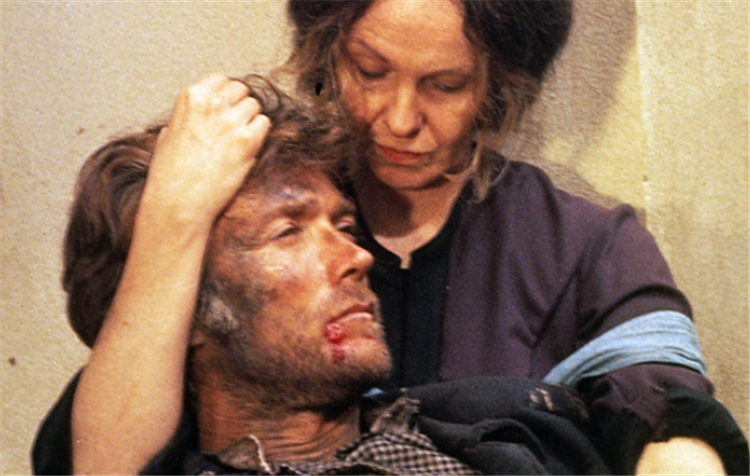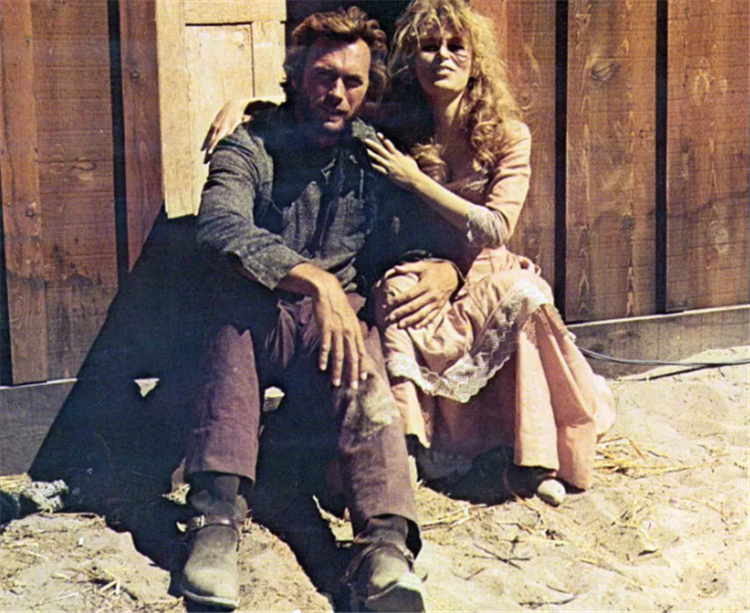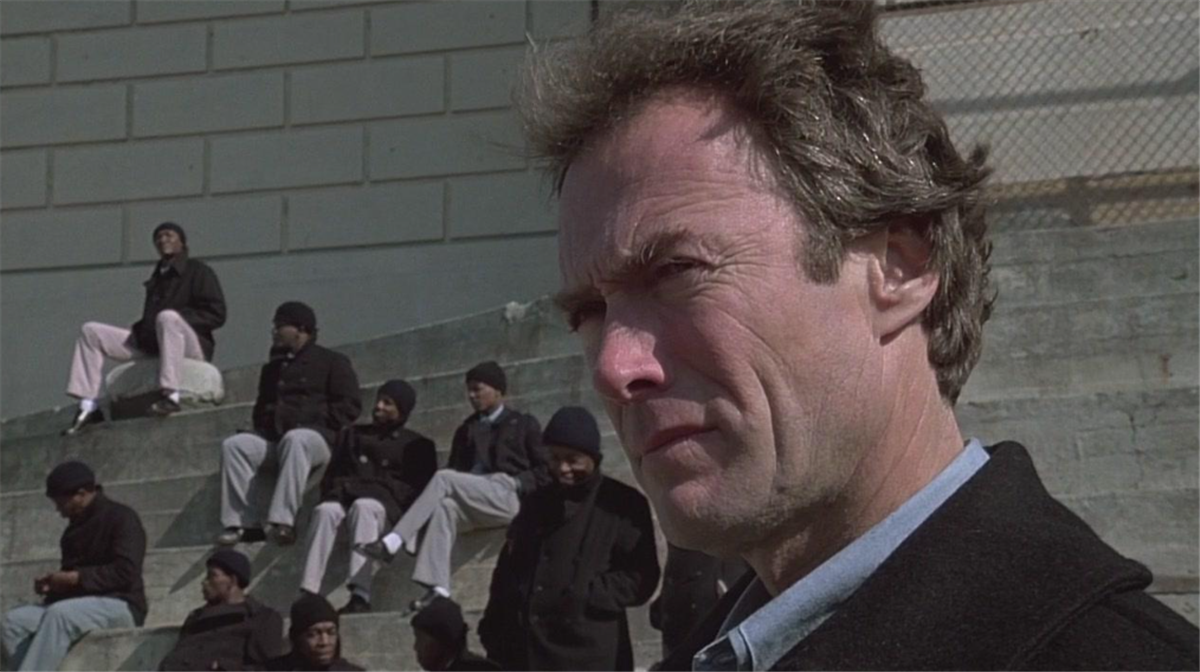Take warning by me, don’t go for a soldier, don’t join no army
For the dove she will leave you, the raven will come
And death will come marching at the beat of a drum
Come all you pretty fair maids who walk in the sun
And don’t let your young man ever carry a gun
By 1971, Clint Eastwood’s image as a macho Western\action star was firmly in place. Sergio Leone’s Dollars trilogy and the subsequent Hollywood Western\War films like Hang’em High. Where eagles dare, Kelly’s Heroes , etc.. had made Clint one of the most popular and bankable film stars in the world. So it’s most surprising that, for two of the three movies he made in 1971, he choose to play very vulnerable, and even flawed characters, who comes under attack, not from Nazis, or cattle barons or bandits, but from women. One of them was Play Misty for Me, with which Clint made his directorial debut. Play Misty was a precursor to ‘psychotic women on the rampage’ films like Fatal Attraction and Basic Instinct that would come almost a decade and half later. But his other film, The Beguiled, which he made with his favorite director and his second mentor Don Siegel (Leone was the first), is the most strangest film of his career; not only his , but also Don Siegel’s, who specializes in making minimalist action pictures. Both Clint and Don would go on to make the iconic ‘Dirty Harry‘ in the same year, which would turn Clint into a megastar. but before that, they will give us this really bizarre film, which is undoubtedly Clint’s most ambitious film as a star\actor. The Beguiled was keeping in line with New-Hollywood sensibilities that was producing truly bizarre movies like Easy Rider, Midnight Cowboy and McCabe & Mrs. Miller. This is a small-scale, character-driven story that was a big change for Clint at the time – who was mainly doing big budget action films -, though in later years, it would become the norm for him, especially as a director. Just like Plat Misty for Me, The Beguiled has a basic plot that could be summed up as: Red-blooded, heterosexual man’s ultimate fantasy turns into his worst nightmare. In Play Misty for me, it was a sultry, sexy woman throwing herself at the shy radio jockey played by Clint; in The Beguiled, Clint plays a wounded union soldier who finds himself in an all-girl boarding school – the proverbial rooster in the hen-house – and being tended to by both the teachers and students of the institution, who become increasingly obsessed with him. And just as in Play Misty, where the woman turns out to be a raging psychopath who pretty much destroy’s the protagonist’s life; here, mutual jealousies between the woman, regarding their affections for the protagonist, and the protagonist’s unapologetic, free-wheeling sexuality would lead to his doom. The film has a fever-dream like quality, mirroring, both the state of the protagonist, as well as the repressed woman, whose sexual desires slowly rises to the fore in the presence of this really attractive stranger. It looks and feels very different from any film Don Siegel has ever made; complete with over-heated dream sequences, avant-garde editing styles and a group of characters who are utterly unsympathetic and deceitful.

But then, John lands the ultimate prize: the frosty Martha herself; who seemed to be quite hostile to him initially, but after a point of time, warms to him like nobody else in the seminary; John’s rugged masculinity stirring long dormant memories and passions inside her – including the memory of a forbidden incestuous tryst with her own brother. Obviously, John’s skills at lying and sexually manipulating his victims comes in handy while dealing with Martha, who is a complex, bizarre character herself, and is dying to find a substitute for her ‘brother’ in her life. She first gets John into her brother’s clothes, and then invites him to her room for a quite drink. The scenes of courtship between John and Martha are staged in a Rashomon style montage by Siegel. When John explains to Martha how he was wounded, he says he is a pacifist Quaker medic, while a flashback reveals that he was a infantryman who did his fair share of killing; including treacherously shooting confederate soldiers in the back. Later, when Martha begins to entertain the idea of keeping John on to help run the school, he claims, ‘I have a great respect for land’, but a flashback shows him torching haystacks as part of the Unionists’ scorched earth campaign. It’s a fitting device to showcase the developing infatuation between two deceitful people. Now the seminary pretty much in his control, the defining moment arrives for John: he has to choose which woman he is going to sleep with. He cannot put it away anymore (nor does he wants to). Martha has made her intentions clear that she wants him to be with her(and so have the other two women). The night when Martha keeps his door unlocked, John, clutching his crutches, walks out of his room and come to the cross point between Edwina and Martha’s rooms. He pauses for a moment to think which door to open. But then, he is lured away by Carol to her room. And as they noisily make love in her room, their sounds reaches Edwina who barges into Carol’s room and finds John and Carol in bed. In a fit of jealous rage, she strikes John, sending him plummeting down the stairs. His leg that has not yet recovered fully, is now fractured at three different places. Martha, who was expecting that John would come to her room, takes a look at the wounded leg and decides that only way to stop gangrene from setting in and saving John’s life is to amputate that leg. John is heavily sedated and Martha performs the operation. John wakes up to find one of his legs missing and he flies into a rage. He blames Martha for acting out of vengeance for turning down her sexual advances. He later gets drunk, get hold of a gun and starts violently threatening the inmates of the seminary. He exposes Martha’s hypocrisy and proves she was had an incestuous liaison with her brother. He also exposes the other women for what they truly are: sexually repressed, immoral women panting for his affections. But in the middle of his rage, he does something unpardonable: he accidentally kills Amy’s pet turtle, thus angering and alienating Amy, the only true friend he had in the seminary. Now that John has spoken the truth and unmasked their hypocrisy, the women decide that he must die, especially with the Union forces fast approaching. They decide to kill him in the most painless way possible: by feeding him his favorite mushrooms, albeit this time poisoned. John, though by this time is sufficiently chastised, and prepares to leave the seminary with Edwina, who has genuinely fallen in love with him. Martha and the women invites John to a final dinner with them. At the dinner, he apologizes to everyone for his behavior,but, it’s too late. He has eaten the poisoned mushrooms, and he collapses and dies. The women convinces each other that John died of exhaustion. The next day, the women sew his corpse into a burial shroud and carry him out of the gate to bury.

It’s interesting to note the progression of John’s character(and Clint’s performance). At first he is all bloodied and bearded, and kept locked up in the music room, totally dependent on others. In the next stage, he gets a couple of crutches to move around. then he gets a shave from Hallie, and we, and the women, see him in all his gorgeousness.All through these stages, Clint’s performance is very subtle and charming. He changes his voice and body language to fit the perception of whichever women he is seducing. By the time he has his full blown sexual encounter with Carol, he is pretty much a megalomaniac, who believes he is untouchable. But then, he loses his leg, and realizes that he has woefully underestimated the women, and he hits the ceiling. Clint’s performance becomes over the top: screaming his words out, gritting his teeth, heavily rolling his eyes and exaggerated body language. In the end , he comes back to his earlier demeanor : subtle and charming. Indeed, This is one of Eastwood’s best and most complex performances. Clint, who usually acts very subtly through squints and monosyllables, gives a performance here, that’s alternatively fiery, charming and expressionistic. Clint looked at the role as a welcome change from what he referred to as ‘Operatic acting’, where he is mainly called upon to do crazy things: like lighting a cannon with a cigar. Here he is called upon to embody a real character with real emotions. Of course, With such a different theme and such an unheroic role for Clint Eastwood, it’s no surprise that the film was a flop; taking in less than a million dollars in the same year, when Dirty Harry was the year’s second highest grossing film. ‘The Man with no Leg’, as the film was dubbed by a lot of it’s critics, was wrongly marketed by Universal Studios, as a kind of sexually charged Hot-house drama. Clint was so angry with Universal’s marketing that, when his deal with the studio was up, he left to join Warner Bros, and wouldn’t make a film for Universal until 2008’s Changeling.
